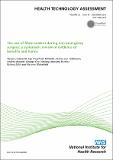Files in this item
The use of fibrin sealant during non-emergency surgery : a systematic review of the evidence of benefits and harms
Item metadata
| dc.contributor.author | Edwards, Steven J | |
| dc.contributor.author | Crawford, Fay | |
| dc.contributor.author | van Velthoven, Michelle Helena | |
| dc.contributor.author | Berardi, Andrea | |
| dc.contributor.author | Osei-Assibey, George | |
| dc.contributor.author | Bacelar, Mariana | |
| dc.contributor.author | Salih, Fatima | |
| dc.contributor.author | Wakefield, Victoria | |
| dc.date.accessioned | 2020-01-15T09:30:04Z | |
| dc.date.available | 2020-01-15T09:30:04Z | |
| dc.date.issued | 2017-01 | |
| dc.identifier | 265462856 | |
| dc.identifier | b41d8058-8229-4d42-9419-2754840bbc0c | |
| dc.identifier | 85009742550 | |
| dc.identifier.citation | Edwards , S J , Crawford , F , van Velthoven , M H , Berardi , A , Osei-Assibey , G , Bacelar , M , Salih , F & Wakefield , V 2017 , ' The use of fibrin sealant during non-emergency surgery : a systematic review of the evidence of benefits and harms ' , Health Technology Assessment , vol. 20 , no. 94 . https://doi.org/10.3310/hta20940 | en |
| dc.identifier.issn | 1366-5278 | |
| dc.identifier.uri | https://hdl.handle.net/10023/19284 | |
| dc.description.abstract | Background Fibrin sealants are used in different types of surgery to prevent the accumulation of post-operative fluid (seroma) or blood (haematoma) or to arrest haemorrhage (bleeding). However, there is uncertainty around the benefits and harms of fibrin sealant use. Objectives To systematically review the evidence on the benefits and harms of fibrin sealants in non-emergency surgery in adults. Data sources Electronic databases [MEDLINE, EMBASE and The Cochrane Library (including the Cochrane Database of Systematic Reviews, the Database of Abstracts of Reviews of Effects, the Health Technology Assessment database and the Cochrane Central Register of Controlled Trials)] were searched from inception to May 2015. The websites of regulatory bodies (the Medicines and Healthcare products Regulatory Agency, the European Medicines Agency and the Food and Drug Administration) were also searched to identify evidence of harms. Review methods This review included randomised controlled trials (RCTs) and observational studies using any type of fibrin sealant compared with standard care in non-emergency surgery in adults. The primary outcome was risk of developing seroma and haematoma. Only RCTs were used to inform clinical effectiveness and both RCTs and observational studies were used for the assessment of harms related to the use of fibrin sealant. Two reviewers independently screened all titles and abstracts to identify potentially relevant studies. Data extraction was undertaken by one reviewer and validated by a second. The quality of included studies was assessed independently by two reviewers using the Cochrane Collaboration risk-of-bias tool for RCTs and the Centre for Reviews and Dissemination guidance for adverse events for observational studies. A fixed-effects model was used for meta-analysis. Results We included 186 RCTs and eight observational studies across 14 surgical specialties and five reports from the regulatory bodies. Most RCTs were judged to be at an unclear risk of bias. Adverse events were inappropriately reported in observational studies. Meta-analysis across non-emergency surgical specialties did not show a statistically significant difference in the risk of seroma for fibrin sealants versus standard care in 32 RCTs analysed [n = 3472, odds ratio (OR) 0.84, 95% confidence interval (CI) 0.68 to 1.04; p = 0.13; I2 = 12.7%], but a statistically significant benefit was found on haematoma development in 24 RCTs (n = 2403, OR 0.62, 95% CI 0.44 to 0.86; p = 0.01; I2 = 0%). Adverse events related to fibrin sealant use were reported in 10 RCTs and eight observational studies across surgical specialties, and 22 RCTs explicitly stated that there were no adverse events. One RCT reported a single death but no other study reported mortality or any serious adverse events. Five regulatory body reports noted death from air emboli associated with fibrin sprays. Limitations It was not possible to provide a detailed evaluation of individual RCTs in their specific contexts because of the limited resources that were available for this research. In addition, the number of RCTs that were identified made it impractical to conduct independent data extraction by two reviewers in the time available. Conclusions The effectiveness of fibrin sealants does not appear to vary according to surgical procedures with regard to reducing the risk of seroma or haematoma. Surgeons should note the potential risk of gas embolism if spray application of fibrin sealants is used and not to exceed the recommended pressure and spraying distance. Future research should be carried out in surgery specialties for which only limited data were found, including neurological, gynaecological, oral and maxillofacial, urology, colorectal and orthopaedics surgery (for any outcome); breast surgery and upper gastrointestinal (development of haematoma); and cardiothoracic heart or lung surgery (reoperation rates). In addition, studies need to use adequate sample sizes, to blind participants and outcome assessors, and to follow reporting guidelines. | |
| dc.format.extent | 252 | |
| dc.format.extent | 3526166 | |
| dc.language.iso | eng | |
| dc.relation.ispartof | Health Technology Assessment | en |
| dc.subject | RD Surgery | en |
| dc.subject | RM Therapeutics. Pharmacology | en |
| dc.subject | 3rd-DAS | en |
| dc.subject.lcc | RD | en |
| dc.subject.lcc | RM | en |
| dc.title | The use of fibrin sealant during non-emergency surgery : a systematic review of the evidence of benefits and harms | en |
| dc.type | Journal item | en |
| dc.contributor.institution | University of St Andrews. School of Medicine | en |
| dc.identifier.doi | https://doi.org/10.3310/hta20940 | |
| dc.description.status | Peer reviewed | en |
| dc.identifier.url | https://www.journalslibrary.nihr.ac.uk/hta/hta20940/#/full-report | en |
This item appears in the following Collection(s)
Items in the St Andrews Research Repository are protected by copyright, with all rights reserved, unless otherwise indicated.

